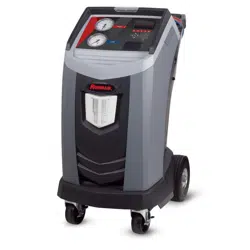Loading ...
Loading ...
Loading ...

3
573104 REV C
Safety Precautions
WARNING: To prevent personal injury,
ALLOW ONLY QUALIFIED PERSONNEL TO OPERATE THE MACHINE. Before operating the machine, read
and follow the instructions and warnings in this manual. The operator must be familiar with air conditioning
and refrigeration systems, refrigerants, and the dangers of pressurized components. If the operator cannot
read this manual, operating instructions and safety precautions must be read and discussed in the operator’s
native language.
USE THE MACHINE AS OUTLINED IN THIS MANUAL. Using the machine in a manner for which it was not
designed will compromise the machine and nullify the protections provided.
PRESSURIZED TANK CONTAINS LIQUID REFRIGERANT. Do not overll the internal storage vessel (ISV).
Overlling can cause explosion resulting in personal injury or death. Do not recover refrigerants into nonrellable
containers; use only type-approved rellable containers that have pressure relief valves.
HOSES CAN CONTAIN LIQUID REFRIGERANT UNDER PRESSURE. Contact with refrigerant can
cause personal injury, including blindness and frozen skin. Wear protective equipment, including
goggles and gloves. Disconnect hoses using extreme caution. Ensure the phase is complete before
disconnecting the machine to prevent the release of refrigeration to the atmosphere.
AVOID BREATHING A/C REFRIGERANT AND LUBRICANT VAPOR OR MIST. Exposure can irritate eyes, nose,
and throat. To remove refrigerant from the A/C system, use only equipment certied for the type of refrigerant
being removed. Use the unit in locations with mechanical ventilation that provides at least four air changes per
hour. If accidental system discharge occurs, ventilate the work area before resuming service.
DO NOT DISPERSE REFRIGERANT INTO THE ENVIRONMENT. Prevent the possible presence of refrigerant
in the working environment.
TO REDUCE THE RISK OF FIRE, do not use the machine in the vicinity of spilled or open containers of
gasoline or other ammable substances.
TO REDUCE THE RISK OF FIRE, do not use an extension cord. An extension cord can overheat and cause
re. If an extension cord must be used, use the shortest possible cord with a minimum size of 14 AWG.
TO REDUCE THE RISK OF FIRE, do not use the machine in the vicinity of ames and hot surfaces. Refrigerant
can decompose at high temperatures and free toxic substances to the environment that can be noxious to
the user.
TO REDUCE THE RISK OF FIRE, do not use the machine in environments containing explosive gases or vapors.
TO REDUCE THE RISK OF FIRE, do not use this machine in ATEX classied zones or areas. Protect the
machine from conditions that can cause electrical failure or other hazards relating to ambient interaction.
CAUTION—DO NOT PRESSURE TEST OR LEAK TEST EQUIPMENT AND/OR VEHICLE AIR CONDITIONING
SYSTEMS WITH COMPRESSED AIR. Mixtures of air and R-134a refrigerant can be combustible at elevated
pressures. These mixtures are potentially dangerous and can result in re or explosion causing personal injury
and/or property damage.
HIGH VOLTAGE ELECTRICITY INSIDE THE MACHINE HAS A RISK OF ELECTRICAL SHOCK. Exposure
can cause personal injury. Disconnect power before servicing the machine.
NEVER LEAVE THE MACHINE LIVE IF AN IMMEDIATE USE IS NOT SCHEDULED. Disconnect the electrical
supply before a long period of inactivity or before internal maintenance is performed.
DO NOT MODIFY THE PRESSURE RELIEF VALVE OR CHANGE THE CONTROL SYSTEM SETTINGS.
Using the machine in a manner for which it was not designed will compromise the machine and nullify the
protections provided.
Additional health and safety information can be obtained
from refrigerant and lubricant manufacturers.
Loading ...
Loading ...
Loading ...
